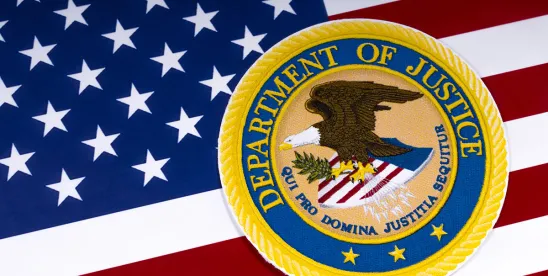The Department of Justice’s Antitrust Division (“Antitrust Division”) recently updated its Evaluation of Corporate Compliance Programs in Criminal Antitrust Investigations guidance document (“Antitrust Compliance Guidance”). Corporate counsel and compliance officers should seriously consider these updates when crafting and implementing an antitrust compliance program.
In July 2019, the Antitrust Division announced its Policy to Incentivize Corporate Compliance and for the first time published the original Antitrust Compliance Guidance. Corporations who had previously clamored for the Antitrust Division to take its compliance efforts into account viewed the original 2019 Guidance favorably. The DOJ’s stated purpose of the Antitrust Compliance Guidance is to assist Antitrust Division prosecutors in their evaluation of compliance programs at both the charging and sentencing stage of investigations, and to provide compliance officers and the public greater transparency of the Division’s compliance analysis. The Antitrust Division’s recent updates follow similar updates to similar Compliance Guidance from the DOJ’s Criminal Division’s Guidance and updates to the DOJ’s Justice Manual.
Much of the Antitrust Compliance Guidance remains the same, but here are some key takeaways on the updates:
1. Application to Civil Antitrust Matters
The Antitrust Compliance Guidance by its very title applied to criminal antitrust investigations, but the updated documents now discusses compliance implications for civil antitrust investigations. The Division says that:
- “While this guidance is focused on criminal risk, a well-designed antitrust compliance program should also minimize risk of civil antitrust violations” including civil actions and monetary penalties for violations of the Hart-Scott-Rodino Act. Antitrust Compliance Guidance at 2.
- “A strong culture of compliance can allow a company to steer clear of civil antitrust violations and, if violations do occur, to promptly self-disclose and remedy them and cooperate with a civil antitrust investigation.” Antitrust Compliance Guidance at 2-3.
- Companies “seeking to resolve investigations into civil antitrust violations” may ask “the Antitrust Division to take notice of existing or improved compliance efforts,” and the civil investigation benefits of an effective compliance program may include being able to “avoid court-mandated further compliance and reporting requirements or retention of and supervision by external monitors.” What mechanisms has the company put in place to manage and preserve information contained within each of the electronic communication channels? Does the company have clear guidelines regarding the use of ephemeral messaging or noncompany methods of communication including the extent to which those communications are permitted and when employees must preserve those communications? What preservation or deletion settings are available, and what is the rationale for the company’s approach to what settings are permitted? Companies should expect the civil team to consider many of the same factors laid out in the Antitrust Compliance Guidance when assessing the effectiveness of their compliance program as criminal prosecutors do.
2. Compliance Should Focus on Electronic Communications
A key recent area of focus of the Antitrust Division & FTC is Preservation Obligations for Collaboration Tools and Ephemeral Messaging, so it is no surprise that several updates to the Antitrust Compliance Guidance relate to prosecutors’ expectations regarding corporate policies governing the use of personal devices and communication platforms to ensure business communications are preserved.
Specifically, in evaluating a corporate compliance programs effectiveness the Division will ask:
- What electronic communication channels do the company and its employees use?
- What mechanisms has the company put in place to manage and preserve information contained within each of the electronic communication channels?
- Does the company have clear guidelines regarding the use of ephemeral messaging or noncompany methods of communication including the extent to which those communications are permitted and when employees must preserve those communications?
- What preservation or deletion settings are available, and what is the rationale for the company’s approach to what settings are permitted?
See Antitrust Compliance Guidance at 6.
3. AI, Pricing Tools, and Revenue Management Software
Another area the Antitrust Division has been highly focused on recently is AI, including pricing tools and revenue management software. Therefore, it is also not surprising that the Division will ask:
- Whether compliance programs and materials are “updated to account for newly developed technology.” Antitrust Compliance Guidance at 5.
- How does the company’s risk assessment address its use of technology, particularly new technologies such as artificial intelligence (AI) and algorithmic revenue management software, that are used to conduct company business?
- As new technology tools are deployed by the company, does the company assess the antitrust risk the tools pose?
- What steps is the company taking to mitigate risk associated with its use of technology?
- Are compliance personnel involved in the deployment of AI and other technologies to assess the risks they may pose?
- Does the compliance organization have an understanding of the AI and other technology tools used by the company?
- How quickly can the company detect and correct decisions made by AI or other new technologies that are not consistent with the company’s values?
See Antitrust Compliance Guidance at 9.
4. Tone from the Middle, Not Just Tone from the Top
Everyone know by now that “tone from the top” is a staple of effective compliance program, but more is now expected from middle managers. Several additions to the Antitrust Compliance Guidance focus on what company management is doing to set a compliant “tone from the middle.” See Antitrust Compliance Guidance at 7. For example, the Antitrust Division notes “[a]n effective compliance program requires leadership to implement a culture of compliance at all levels of the organization,” while another defines management as “both senior leadership and managers at all levels.” Antitrust Compliance Guidance at 6.
5. Whistleblowers, Anti-Retaliation and NDAs
Deep into the updated Antitrust Compliance Guidance, under the heading “Confidential Reporting Structure and Investigation Process,” are a series of new questions that seem to focus on concerns regarding whistleblower retaliation and potential obstruction of justice. The Antitrust Division added this series of questions its prosecutors should now ask when assessing the effectiveness of an antitrust compliance program:
- What mechanisms does the company have in place to allow employees to report or seek guidance regarding potential criminal conduct without fear of retaliation? May employees make anonymous and confidential reports? In practice, are the company’s policies encouraging reporting of antitrust violations or are the policies chilling reporting? How does the company assess whether employees are willing to report violations? Does the company have an anti-retaliation policy? Are employees, including managers and supervisors, trained regarding the anti-retaliation policy and the protections provided under the Criminal Antitrust Anti-Retaliation Act (CAARA)?
- Is the company’s use of non-disclosure agreements (NDAs) and other restrictions on current and former employee consistent with ensuring that employees can report potential antitrust violations without fear of retaliation? Are NDAs utilized or enforced in such a way that they act to deter whistleblowers or violate CAARA? Are the company’s NDAs and other employee policies clear that employees can report antitrust violations internally and to government authorities?
See Antitrust Compliance Guidance at 14.
It is unclear what is driving these updates, but the Antitrust Division is clearly concerned about efforts to deter or gag whistleblowers. It appears the Antitrust Division wants companies to specifically train employees on their CAARA rights of private civil action if they are retaliated against for reporting antitrust violations. This seems an odd burden to put on companies.
It also appears the DOJ perceives NDAs as a potential vehicle to deter whistleblowing or prevent reporting to the government. Perhaps this concern is driven by a decrease in leniency reporting to the Antitrust Division.
Neither of these things seem in the interest of companies. There are potentially more serious ramifications, including obstruction of justice consequences, for companies that prevent reporting or retaliate against whistleblower and those ramifications seem a much bigger deterrent to such acts than being denied compliance credit by the Antitrust Division. Adding these additional expectations to the very long list of questions used to evaluate the effectiveness of a corporation’s compliance program seems to unnecessarily add burden for most companies.
Will These Updates Stick in a New Administration?
With the country and Department of Justice looking toward a change of administration in 2025, many are asking whether these updates to the Antitrust Compliance Guidance will stick or be ripped up when new Department and Antitrust Division leadership arrives is 2025? Given that these recent changes are updates to a policy and guidance developed and introduced in 2019 during the first Trump Administration they are likely to stay in place. So, we will be thinking about this guidance when updating antitrust compliance policies or trainings, and focusing on electronic communications, AI, and the tone from the middle.



 />i
/>i

